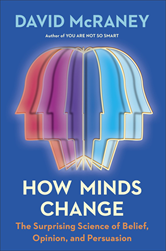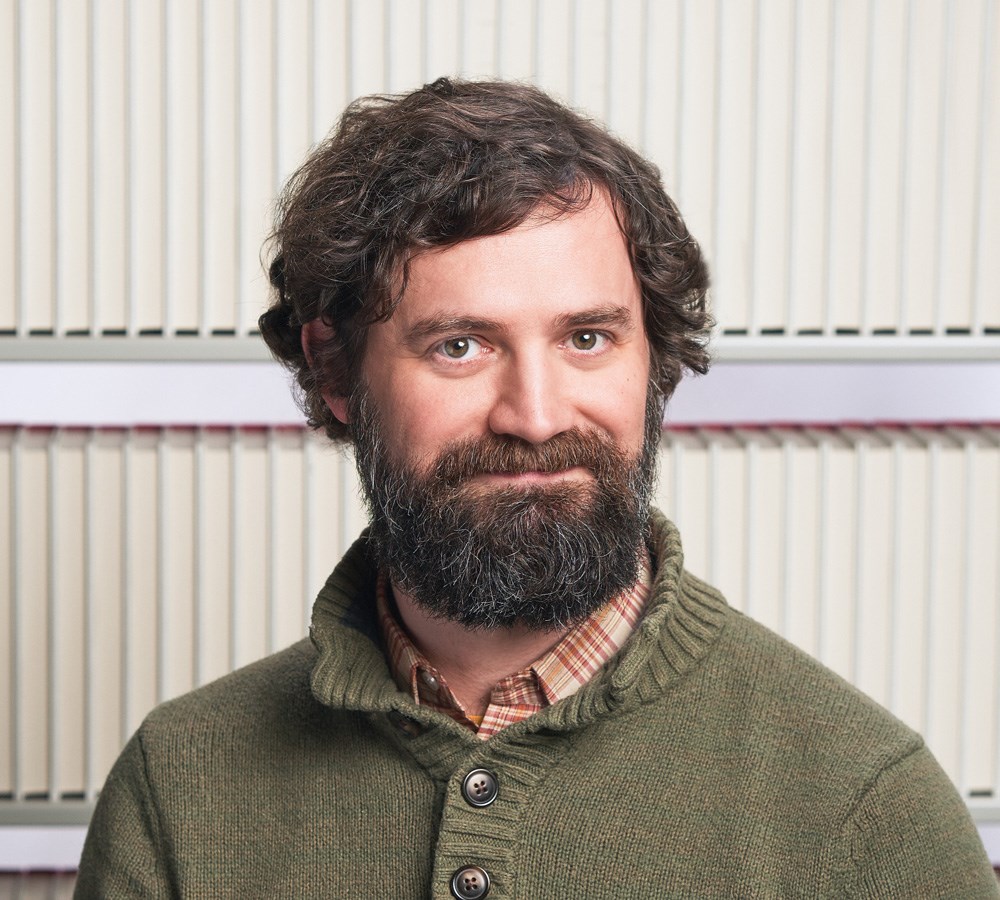How Minds Change: The Surprising Science of Belief, Opinion, and Persuasion
June 24, 2022
David McRaney's new book offers insights on how we can end the contentious debates dividing us and engage in more constructive conversations.
 How Minds Change: The Surprising Science of Belief, Opinion, and Persuasion by David McRaney, Portfolio
How Minds Change: The Surprising Science of Belief, Opinion, and Persuasion by David McRaney, Portfolio
Roe v. Wade was overturned by the Supreme Court this morning, ending the constitutional right to abortion in the United States. I was somehow not prepared for this news, even though it had been expected, and it feels devastating. It is a shock to the system.
Abortion has long been one of the most contentious issues in America. There are few things, if anything, that we disagree more vociferously on. But, as David McRaney says in his new book, How Minds Change, “The fact that we so often disagree isn’t a bug in human reasoning; it’s a feature.” That is hard to accept this morning. Things clearly need to change, but this is not the kind of change I was hoping for. And the way this disagreement has shaken out this morning is likely just the beginning of a new debate and action on reproductive rights.
The level of animosity in our public debate is debilitating. If we are going to continue to govern ourselves effectively, we can’t remain as divided as we are today. And to lessen the level of division, we need to talk to each other even when we disagree. We also need to understand the nature of disagreement better, and that is one of the things McRaney accomplishes in the book.
It can feel as if we are living in completely different realities, and to a certain extent, we are. To explain how and why, McRaney turns to The Dress.
The Dress was a viral phenomenon. Some people saw the picture of the dress as blue and black, others as white and gold. This seemingly silly and baffling phenomenon became the focus of a serious, two year study at an NYU lab to discover how people’s perceptions are shaped and how they differ. In the end, neuroscientist Pascal Wallisch was able to recreate the phenomenon using a picture of him wearing a pair of pink crocs and white socks, shot under a green grow light that made the crocs appear gray and the socks green. Some people, when viewing the picture, saw the crocs and socks as they really were—pink and white—because in their experience tube socks are white, so their brains automatically color corrected for the green light. But some people saw the colors as they really were in the picture, as gray and green. The difference largely broke down along age lines, with older people who grew up in an era where tube socks were only white making the color correction, and younger people who were more familiar with different colored socks accepting the colors in the picture as they were. Both sides were convinced they saw things as they really were, and in reality neither was really wrong. They literally saw things in a different light.
While the color of a dress, or crocs and socks, in a picture taken in ambiguous or alternate lighting may not be of much consequence, our views on reproductive rights, our perceptions of things like the efficacy and safety of vaccines, and how we see a host of other issues on which we are bitterly divided today are of monumental importance to our lives, and the way we come to conclusions on those issues is based on the same process of disambiguation. As McRaney writes:
When we encounter novel information that seems ambiguous, we unknowingly disambiguate it based on what we’ve experienced in the past. But starting at the level of perception, different life experiences can lead to very different disambiguations, and thus very different subjective realities.
McRaney does not get bogged down in the underlying nature of reality itself, eschewing that rabbit hole for how our perceptions of it are formed and how they change. But his primary goal is to understand if, and more importantly how, we can change others’ perceptions through conversation and persuasion. And for that, he turns to the deep canvassing work done by the LAB (Learn Act Build), a part of the Los Angeles LGBT Center. Their goal is to shift public opinion by getting out in the public, knocking on doors and seeing who will talk to them about policy issues ranging from same sex marriage and transgender rights to, yes, abortion. What they have discovered is that, when they find someone willing to talk, it is important to let them do just that. Bombarding people with facts and evidence not only rarely changes people’s minds, but often hardens their stances. We may believe the other side is wrong, but it is more important to understand why and how they have been led to their beliefs, to prompt them to fully think through how they have come to those conclusions and allow them to continue to think it through themselves rather than presenting them with counterarguments. It seems counterintuitive, but the key to persuasion isn’t successfully making your point, or relaying the facts, but allowing others to carefully consider their stance and work it out for themselves. In short:
You want them to think about their own thinking.
The key is to ask questions and listen, to get away from ideology and abstraction and into their real, lived experiences. It is Socratic in that way, but it is not intellectual. Instead of asking people to accept the evidence you believe you have at your disposal, to just see and accept the facts that seem so clear to you, you need to key in on how the issues have affected their lives, their connection to others, and the emotions that are bound up in the issue. Intellectual arguments do not work. Accessing people’s emotions does. And letting people talk is a more effective way to change minds than talking at them. Even if we still disagree with them in the end, it also helps us make a connection to them, to find common ground and humanity even with people we disagree with.
If we can see that, it can lead to something Pascal and others at NYU are calling cognitive empathy: an understanding that what others experience as the truth arrives in their minds unconsciously, so arguments over conclusions are often a waste of time. The better path, they said, would be for both parties to focus on their processing, on how and why they see what they see, not what.
As we’ve learned from the work of Amos Tversky and Daniel Kahneman and so many behavioral psychologists who have followed them, we are primed by evolution to use cognitive shortcuts and tend to exist on a kind of intellectual autopilot. When people do change their minds, they very often don’t even notice it. It is a phenomenon known as elaboration, “a state of active learning in which a person unpacks a new idea by relating to something they already understand.” In that way, it doesn’t register so much as a change as an addition or evolution of what they already know or believe. As McRaney writes of the LAB’s effective methodology:
As people explain themselves, they begin to produce fresh insights into why they feel one way or another. This indicates they’ve engaged in active processing. Instead of defending, they begin contemplating, and once a person is contemplating, they often produce their own counterarguments, and a newfound ambivalence washes over them. If enough counterarguments stack up, the balance may tip in favor of change.
I realize I live in a bubble. Everyone I communicate regularly with, from my family and my friends to my colleagues and other parents at my kids’ school, holds pretty similar viewpoints and values as I do. There is basically zero chance that I will encounter someone this weekend who celebrates this morning’s decision, but I know that—even if they are in the minority—there will be large swaths of people and entire communities that do. And it is that movement of people and thought that prevailed today. For all I’ve read (and written) about the importance of engaging in conversations with people who we might disagree with (Celeste Headlee’s We Need to Talk, Robert Livingston’s The Conversation, and many others), I've lately become very skeptical about the efficacy of doing so. I have told multiple people recently I’m not so sure that I even care what is in people’s heads and hearts anymore, or in changing it, that I just want people to find some reason—any reason—to vote for what it seems to me is clearly in their own interests—for things like universal health care, a stronger social safety net, civil rights, women’s rights, voting rights. David McRaney’s new book, How Minds Change, has convinced me I am mistaken—that engaging in those conversations is vital. But, in doing so, we have to stop trying so hard to prove our point, to break through to other people, and allow them to have a breakthrough of their own, and to be open to having some ourselves.
[W]e must avoid debate and start having conversations. Debates have winners and losers, and no one wants to be a loser. But if both sides feel safe to explore their reasoning, to think about their own thinking, to explore their motivations, we can avoid the dead-end goal of winning the argument.
In the book, McRaney talks to a 9/11 conspiracy theorist and online influencer who changed his mind, looks at how hate group and cult members have been able to break free of the belief systems and social circles they existed in, and discusses the phenomenon of posttraumatic growth. It is in these examples, in knowing that we need change and that it is possible—and that a shock to the system, maybe repeated shocks to the system, might be exactly what we need—that I find some hope today. We’ve all experienced some trauma over the last few years. Is it possible for an entire society to experience posttraumatic growth? If we are unwilling to talk to each other, probably not. But if we get out and engage in constructive conversations with people we don’t agree with, we might have a shot.



